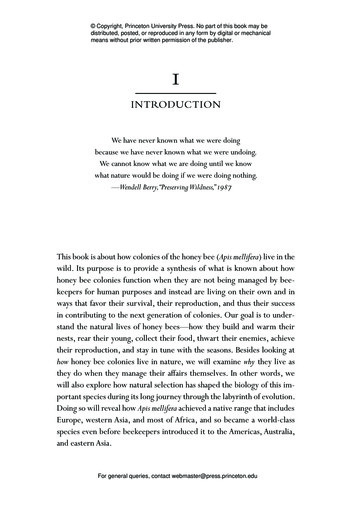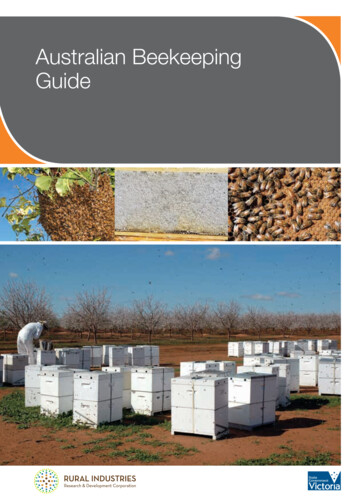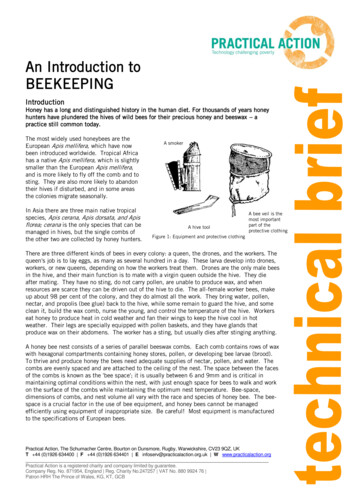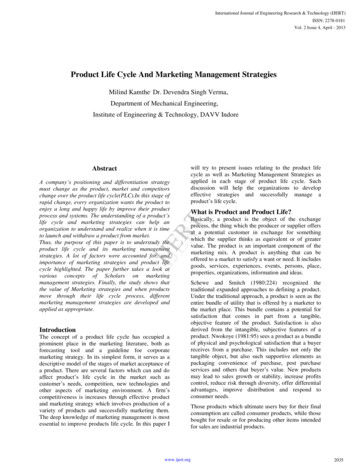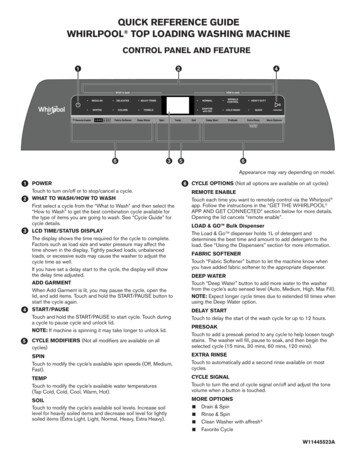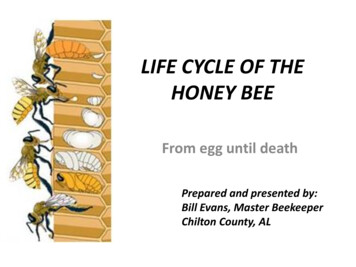
Transcription
LIFE CYCLE OF THEHONEY BEEFrom egg until deathPrepared and presented by:Bill Evans, Master BeekeeperChilton County, AL
Three Castes of Bees in a Colony A honey bee colony is an organized society ofthree adult castes of bees:– Queen,– Workers, and– Drones. Each caste has its own certain specializedresponsibilities for the ongoing operation,maintenance and preservation of the colony.
Three Castes of Bees in a ColonyTwo castes are female, the queen and the worker, andonly one caste is male, the drone.
Queens Queens, responsible for producing and layingeggs, live an average of 2-3 years, but some canlive up to 5 years. Domesticated queens may die earlier, asbeekeepers “re-queen” the hives frequently. A single queen can potentially lay millions ofeggs throughout her life.
Queens (Continued) In order for a colony to survive, the queen needsto lay a massive number of fertilized eggsthroughout her productive life. Young, vigorous queens are desirable becausethey have a higher capacity for egg laying. Queens who experience diminished egg layingability will be superceded by the colony. The workers, produced from the fertilized eggs,will forage for food, build a strong and wellinsulated hive, take care of larvae and defend thecolony from enemies.
Queens (Continued) The queen mates only one time in her life butshe mates with as many as two dozen drones,to assure genetic diversity in the colony. Aftermating, aqueen canlay up to2,000 eggsin a singleday!
Drones Queens also produce unfertilized eggs that hatch intodrones, or male honey bees. The sole purpose of drones is to mate with a queen, andtheir life span relates directly to this task. Should a drone succeed in mating, he soon dies because hispenis and the associated abdominal tissues are ripped fromthe drone's body after sexual intercourse. If he is unsuccessful in the mating flight, the drone will beejected from his hive at the end of the active summerseason and will eventually die of cold or starvation.
Drones(Continued) The drones spend their days flying out to dronecongregation areas (DCAs) in the early afternoonand flying home just before dark. They spend their entire lives in hopes of finding aqueen to mate with. Dr. Keith Delaplane, of the University of Georgia,describes drones as “flying sperm”.
Workers Worker bees are thesmallest members of thecolony, but they comprisethe largest number:– A hive can contain from20,000 up to 80,000workers. The life span of worker honey bees ranges from five to sevenweeks, during their active spring and summer months. The first few weeks of a worker’s life are spent working insidethe hive as house bees, while the last few weeks are spentoutside the hive as field bees, foraging for nectar and pollen.
Workers (Continued) After 3 days, eggs hatch into worker larvae. During this stage, each larva will be fed about1,300 times a day! They are fed byyoung worker beesthat have thespecific task oftending the brood,and are referred toas the “broodnurses”.
Workers (Continued) The food is made from pollen, honey andsecretions of enzymes produced by the broodnurses. This food is called “bee bread”.
The Four Stages of MetamorphosisHoney bees go through four stages, from egg to adult.
Duration of the Metamorphosis The life cycle of honey bees begins when an egghatches. During the first stage of its development, theoffspring form a digestive system, a nervoussystem and an outer covering (the exoskeleton). Each member of a colony develops, afterhatching, as an adult over varying durations:– Queens become full-grown adults within 16 days,– Workers develop into adults in 21 days,– Drones require 24 days.
Larval & Adult Life Cycle of a Worker BeeThe cycle for a worker bee is approximately 9 weeks from egg to death.
Egg Stage The first stage of physicaldevelopment in the life cycleis the egg stage. The queen determines, eachtime, whether she will lay afertilized or an unfertilizedegg, based on the cell size. Eggs are very minute and havethe appearance of grains ofrice in size, shape and color. Hatching of the egg normallyoccurs after three days fromthe egg being laid.
Generally lasts up to ten days.Larval Stage Larvae are fed on a diet known asroyal jelly for the initial 2 days. Royal jelly is produced by thehypopharyngeal gland in the head ofthe workers. As the 3rd day progresses, larvaedestined to develop into queen beescontinue to be fed on royal jelly,while worker larvae feed on honey,pollen and water. Larval stage duration:– Queen: 5.5 days,– Worker: 6 days– Drone: 6.5 days.
Pupal Stage Massive reorganization of bodilytissues takes place during thepupal stage. The worm-like body has nowthree distinct parts:– Head,– Thorax, and– Abdomen This stage usually lasts for:– 7.5 days for the queen,– 10 days for the worker, and– 14.5 days for the drone.
Adult Stage All three castes of bees are now fully matureand they are ready to accomplish theirbiologically pre-determined tasks. A typical colony of honey bee consists of:– 50,000 to 60,000 worker bees,– 600 to 1,000 drone bees, and– Only 1 queen bee (ordinarily).
From Egg to Adult Field BeeThree weeks (21 days) from egg to adult then six weeks as a worker.
Yearly Cycle of the Colony Honey bee colonies perform very differentlydepending on the season that they areexperiencing:– Spring– Summer– Fall– Winter
Spring By spring the colony is building up well. Theyshould have raised at least one turnover of broodby now. They will really take off with the first bloom. Thisdepends on what is flowering in your area. Between early springand mid-May thecolony will be intenton making swarmpreparations.
Spring (Continued) They will try to finish building up and then startback-filling the brood nest with nectar so that thequeen can't lay. This sets off a chain reaction thatfrequently leads to swarming. If they decide to swarm, then the old queenleaves the hive with a large number of the youngworker bees and they go off to start a new homeelsewhere. Meanwhile the new queen emerges in a coupleof weeks and starts laying after her mating flightis accomplished.
Summer Nectar flow occurs mostly in the spring andearly summer. This is usually followed by alate summer lull. Depending on the area, the primary nectarflow runs from mid-spring until it ends whenblooming ceases in late summer. Beekeepers need to beaware of flowering plantsthat create nectar flowsin their area.
Fall We sometimes get a fall nectar flow. It's mostly goldenrod, aster and chicory withsome sunflower, along with partridge pea andother weeds. Some years it's not enough to get the beesthrough the winter and they have to be fed. Usually around midOctober, queensstop laying and thebees start settling infor the winter.
Winter The colony should go into winterwith sufficient stores, not only tosurvive the winter, but to buildup enough by spring for thecolony to reproduce. To do thisthe colony needs lots of honeyand pollen. The bee colony appears to bedormant all winter. They don'tfly unless the temperatures getup to around 50 Fahrenheit. Once a brood nest is established, the cluster mustmaintain a constant temperature between 94.1 -98.0 Fahrenheit inside the cluster all winter.
Winter (Continued) The cluster takes a lot of energy to maintainbrood temperature. As soon as there is any supply of fresh pollencoming in, the colony will begin buildup inearnest. Usually the early pollen is from theMaple and Poplar trees. Beekeepers often put pollenpatties on at this time so theweather won't be a decidingfactor in the buildup.
Enjoy your exciting new hobby keeping honey bees.There is much for you to learn so takeadvantage of every opportunity.Join your local and state beekeeperassociations and get involved!
Thank you for your time and attention!QUESTIONS?
If you would like to have a copyof this presentation for review,it is available on my websitewww.RoseHillFarmLLC.comalong with other presentations of mine.
My Contact Info:Bill Evans, Master BeekeeperEmail: Bill@RoseHillFarmLLC.comWebsite: www.RoseHillFarmLLC.comHome Phone: (205) 688-1287Cell Phone: (205) 310-3800
The life span of worker honey bees ranges from five to seven weeks, during their active spring and summer months. The first few weeks of a worker’s life are spent working inside the hive as house bees, while the last few weeks are spent outside the hive as field bees, foraging for

